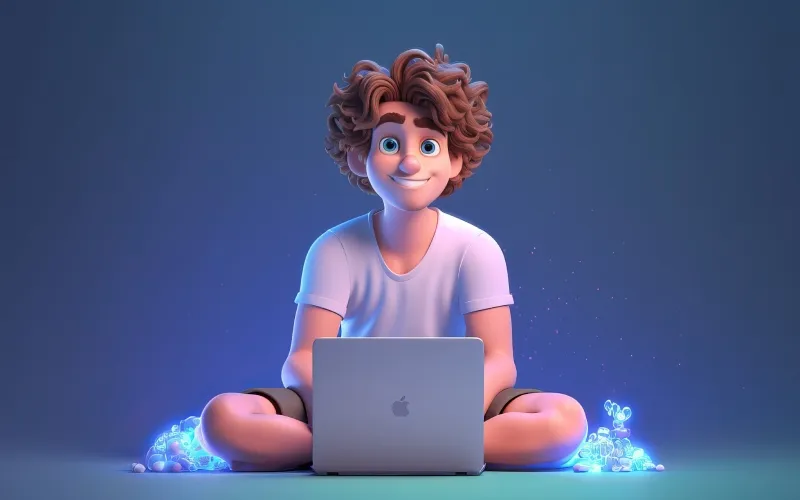Think of creating dragons out of myth or constructing cities of the future that glisten with potential. The year 2025: 3D animation turns the impossible into reality and drives blockbuster movies, immersive video games, advanced healthcare simulations, and moving e-commerce visualizations. The animation production market in the world is on the rise and it is expected to be almost USD 2025 billion in the coming year, and 3D animation alone is expected to exceed USD 26 billion this year. In the UAE, the smart city and digital entertainment drive has led to an increased demand for 3D animators. Are you a total novice or an aspiring artist in Dubai or Abu Dhabi? This all-inclusive guide gives you a step-by-step plan, professional tips, local knowledge, and frequently asked questions to enable you to master professional-level 3D animation, even without having ever used 3D software.
What is 3D Animation? The 2025 vision of 3D Animation.
3D animation is the skill of producing realistic motion in a three-dimensional digital environment. Contrary to the 2D animation where the visuals are flat, 3D animation gives the artist the ability to create scenes with depth, perspective, and even photorealistic detail. Consider a 3D model as a computer-generated sculpture that may be turned, illuminated, and animated to emulate the physics of the real world or an imaginary universe.
Some Important Differences Between 2D and 3D Animation:
- 2D Animation:
Simple, drawn or vector images, such as conventional cartoons or contemporary shows such as Adventure Time.
- 3D Animation:
Digital models of height, width, and depth, which are manipulated using virtual cameras and lighting to look realistic, as in a movie such as Avatar or a game such as God of War.
2025 Trends Shaping the Industry
The 3D animation industry is fast changing due to technological changes and innovative creativity. The best trends 2025 are as follows:
- AI-Assisted Modeling:
Applications such as Meshy AI enable creators to create complex 3D assets based on a single text prompt, and reduce time spent creating characters, environments, and props by orders of magnitude.
- Real-Time Rendering:
With engines such as Unreal Engine 5, the result of the visuals is of finished quality, meaning there is no longer a render time, and the iteration can be made much faster.
- Hybrid 2D/3D looks:
Encouraged by such successes as Spider-Man: Into the Spider-Verse and Arcane, studios are mixing the artistic appeal of 2D and the depth of 3D to create striking, expressive images.
- Cloud Collaboration:
Software tools such as Autodesk Flow Production Tracking allow worldwide teams to interact with each other without difficulties, and high-end animation becomes available from Dubai to New York.
Learn Why You Should Learn 3D Animation.
The market of 3D animators is soaring, which provides a variety of options:
- Lucrative Careers:
3D talents are sought by film studios (Pixar, DreamWorks), game developers, creative agencies in the UAE and healthcare companies. The minimum wages in UAE may be AED 8,000-12,000 per month, whereas high-ranked positions can reach AED 25,000.
- Versatile Applications:
Other than entertainment, 3D animation is used in medical simulations, augmented reality (AR)/ virtual reality (VR) applications, engineering processes, and interactive e-commerce presentations.
- UAE Demand:
The vision of the UAE (smart cities, cultural preservation initiatives, etc.) and such events as Dubai Design Week have given rise to the boom in the local 3D design jobs, including architectural visualization and immersive storytelling.
Pre-Production: The Foundation
The best animations are planned well. In pre-production, you establish your vision so that your project can be exciting to audiences.
Step 1: Concept & Storyboarding
All the most memorable animation such as Finding Nemo, UAE heritage showcases, etc. starts with a great idea. Take your time to brainstorm a story that you can relate to, may it be the story of a dragon or the skyline of Dubai in the future.
How to Start: Ideate:
List your main idea. As an example, a sci-fi desert could be a short film about a Bedouin explorer. The UAE culture will be mixed with futuristic style.
Storyboard:
Draw out every scene in order to draw out pacing, camera angles, and emotional arcs. Even sketches, though not very smooth, assist in seeing the flow.
Tools:
- Blender:
Free and flexible to do storyboarding and blocking key shots.
- Miro:
A collaborative brainstorming platform that works best when you want to collaborate with teammates in the UAE or the world. Pro Tip: Read about the cultural aspects of UAE, such as falconry or typical souks, to be inspired to write something that will resonate with the locals.
Step 2:
Writing the script
A good script makes your visuals a part of a story. Write sparse dialogue, character actions and camera movements (e.g. pan across the Sheikh Zayed Mosque in Abu Dhabi at sunset).
Successful Tips:
Make conversation concise and effective. Emphasize on emotional beats to direct the emotions of the audience. In case you are not good at scripting, you can hire a freelance scriptwriter through websites such as Upwork or Fiverr.
Step 3:
Designing of Assets Design characters, environments and props before you model them.
Gather sources:
Pictures of the deserts in the UAE, skyscrapers, or native clothes will help to make your work authentic.
Tools:
- Procreate:
Easy to use to sketch on iPad, excellent to use on character and environment ideas.
- Adobe Substance 3D:
Builds conceptual digital art that has realistic textures.
- Production:
Modelling in Motion It is in production that your vision comes into 3-dimensional space. This stage is modeling, texturing, rigging, and animation.
Step 4:
3D Modelling Modeling converts your sketches into 3 dimensional assets. Begin with a basic shape and develop it to a detailed character or scenery.
Top Software in 2025:
- Blender:
Free, open-source, and potent both to amateurs and professionals. This is common in UAE due to its accessibility.
- Autodesk Maya:
The professional tool used in the film and AAA game industry, but it is a paid license.
- Meshy AI:
It creates 3D models based on text descriptions or sketches, ideal in the case of fast prototyping.
Pro Tip:
Start with the simplest models (fewer polygons), called low-poly models to streamline the rigging process and to make the work faster, particularly on a typical laptop.
Step 5: Texturing- Materials
Texturing brings color, detail and realism to your models, and makes them appear life-like when lit in the virtual environment.
Tools:
- Substance Painter:
It enables you to paint on 3D objects to achieve photorealistic outcomes.
- AI-Generated PBR Materials:
AI-generated materials are Physically Based Rendering (PBR) materials, which are available through tools such as Quixel Megascans, and make the surfaces respond to light in a realistic way.
- UAE Context:
Add some textures that are based on common materials of the place, such as the patterns of Emirati fabrics or the gloss of the desert sand.
Step 6: Rigging and Animation
- Rigging:
Construct a digital skeleton within your creation in order to make it move like a real one. There are powerful rigging tools in Blender and Maya.
- Animation Techniques:
Keyframing: Involves manually placing a pose on a particular frame to give exact and stylized movements (e.g. a dragon flapping its wings).
- Motion Capture (Mocap):
Place suits or AI-assisted equipment on a real person to capture their movements to create hyper-realistic animation, which is suitable to humanoid characters.
Post-Production: Shining Up Your Masterpiece
Post-production polishes your animation to be ready to be shown to an audience.
Step 7 Lighting and Rendering
- Lighting:
Natural shadows and dramatic effects will be achieved with the help of High Dynamic Range Imaging (HDRI) maps. In example, a futuristic city scene can be lit with an HDRI of the skyline of Dubai to make it look realistic.
Rendering Engines:
- Cycles (Blender):
Provides photorealistic output, ideal in making high quality shorts.
- Redshift:
Famous with speed, suitable to complicated scenes in professional studios.
Step 8: VFX & Compositing
To make your animation special, add visual effects such as explosions, smoke, or glowing sci-fi features.
- After Effects:
Easy to use when adding transitions, text or particle effects.
- Nuke:
Industrial-strength detailed compositing, applied in movies such as Dune.
Step 9: Sound Design
Audio makes images interactive. A flying dragon requires roaring winds, and a futuristic city of UAE requires humming of tech.
Resources:
- Freesound.org:
Free and high-quality sound effects of footstep, wind or explosion.
- Epidemic Sound:
Royalty-free music to get the mood, epic orchestral, modern Arabic beats, etc.
Some of the Common Mistakes to Avoid as a Beginner
- Foregoing Storyboarding:
If you do not use a storyboard, you might not have a pacing or clarity in your animation, and this will be a waste of time during production.
- Premature Abstraction:
The intricacy of models may confound your system or delay an advancement. Begin with basic shapes and then add detail to them.
- Soundlessness:
Even beautiful images are dull without surround sound. Never skip on sound design.
(FAQs)
Q1: Do I need a powerful computer to start 3D animation?
A: No, necessarily. Such tools as Blender can be used on mid-range laptops (8GB RAM, good GPU). In case of complex projects, you may need cloud rendering services or upgrade the RAM to 16GB and an NVIDIA GPU to get a smoother performance.
Q2: How long will it take me to learn 3d animation?
A: The ability to get basic proficiency requires 3-6 months of regular exercises (5-10 hours/week). It can be 1-2 years before you master the workflows of professionals, which depend on your commitment and the complexity of your project.
Q3: Is Blender suitable for professional use?
A: Absolutely. Blender is used by studios worldwide for movies, games and visualizations. It can be freely accessed and has a large community, which make it suitable to both beginners and professionals, particularly in the UAE.
Q4: Is it possible to learn without drawing skills?
A: Yes! Although sketching is useful in storyboarding and asset design, using third-party tools such as Meshy AI and bought assets (e.g. Sketchfab) enables you to concentrate on modeling and animation without having to draw.
Q5: Do 3D animators have employment in UAE?
A: Yes, the smart cities, tourism, and entertainment needs of the UAE demand it. Architectural visualization, game design, and cultural projects are employed in companies in Dubai and Abu Dhabi. Look at local listings in sites such as LinkedIn or Bayt.com.
Q6: How do I bring the UAE culture to my animations?
A: You can use such references as Emirati architecture (e.g., Burj Khalifa, Sheikh Zayed Mosque), patterns or landscapes of the desert. Such tools as Procreate and Substance Painter allow you to create culturally inspired assets.
Q7: How should one begin as a novice in UAE?
A: You can download Blender and go through free tutorials on YouTube or CG Cookie and join some local communities, such as Dubai Design Week. Learn by doing small projects, such as animating a falcon or a skyline of the UAE.
Conclusion
In 2025, 3D animation is the key to unlimited creativity, where art and technology are used to create dragons, cities, or stories that audiences love to listen to all over the world. You might be striving to make it in Hollywood, play your part in the development of the UAE as a smart city, or share your own stories based on Emirati culture, but the tools and methods have never been so available. Begin with a small idea, use free software such as Blender and follow this guide to turn your vision into reality.


